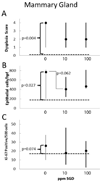Effects of Flaxseed Lignan Secoisolariciresinol Diglucosideon Preneoplastic Biomarkers of Cancer Progression in a Model of Simultaneous Breast and Ovarian Cancer Development
- PMID: 26010915
- PMCID: PMC5025029
- DOI: 10.1080/01635581.2015.1042549
Effects of Flaxseed Lignan Secoisolariciresinol Diglucosideon Preneoplastic Biomarkers of Cancer Progression in a Model of Simultaneous Breast and Ovarian Cancer Development
Abstract
Breast cancer prevention efforts are focused increasingly on potentially beneficial dietary modifications due to their ease of implementation and wide acceptance. Secoisolariciresinol diglucoside (SDG) is a lignan found in high concentration in flaxseed that may have selective estrogen receptor modulator-like effects resulting in antiestrogenic activity in a high estrogen environment. In parallel with a human phase II prevention trial, female ACI rats (n = 8-10/group) received 0, 10, or 100 ppm SDG in the feed. The 100 ppm SDG treatment produced similar blood lignan levels as those observed in our human pilot study. Mammary and ovarian cancer progression were induced using local ovarian DMBA treatment and subcutaneous sustained release 17β-estradiol administered starting at 7 weeks of age. Mammary gland and ovarian tissues were collected at 3 mo after initiation of treatment and examined for changes in epithelial cell proliferation (Ki-67, cell counts), histopathology, and dysplasia scores, as well as expression of selected genes involved in proliferation, estrogen signaling, and cell adhesion. Treatment with SDG normalized several biomarkers in mammary gland tissue (dysplasia, cell number, and expression of several genes) that had been altered by carcinogen. There is no indication that SDG promotes preneoplastic progression in the ovarian epithelium.
Figures





References
-
- Lowcock EC, Cotterchio M, Boucher BA. Consumption of flaxseed, a rich source of lignans, is associated with reduced breast cancer risk. Cancer Causes Control. 2013;24:813–816. - PubMed
-
- Lindahl G, Saarinen N, Abrahamsson A, Dabrosin C. Tamoxifen, flaxseed, and the lignan enterolactone increase stroma- and cancer cell-derived IL-1Ra and decrease tumor angiogenesis in estrogen-dependent breast cancer. Cancer Res. 2011;71:51–60. - PubMed
-
- Nesbitt PD, Lam Y, Thompson LU. Human metabolism of mammalian lignan precursors in raw and processed flaxseed. Am J Clin Nutr. 1999;69:549–555. - PubMed
-
- Bergman Jungestrom M, Thompson LU, Dabrosin C. Flaxseed and its lignans inhibit estradiol-induced growth, angiogenesis, and secretion of vascular endothelial growth factor in human breast cancer xenografts in vivo. Clin Cancer Res. 2007;13:1061–1067. - PubMed
-
- Thompson LU, Rickard SE, Orcheson LJ, Seidl MM. Flaxseed and its lignan and oil components reduce mammary tumor growth at a late stage of carcinogenesis. Carcinogenesis. 1996;17:1373–1376. DOI. - PubMed
Publication types
MeSH terms
Substances
Grants and funding
LinkOut - more resources
Full Text Sources
Other Literature Sources
Medical
